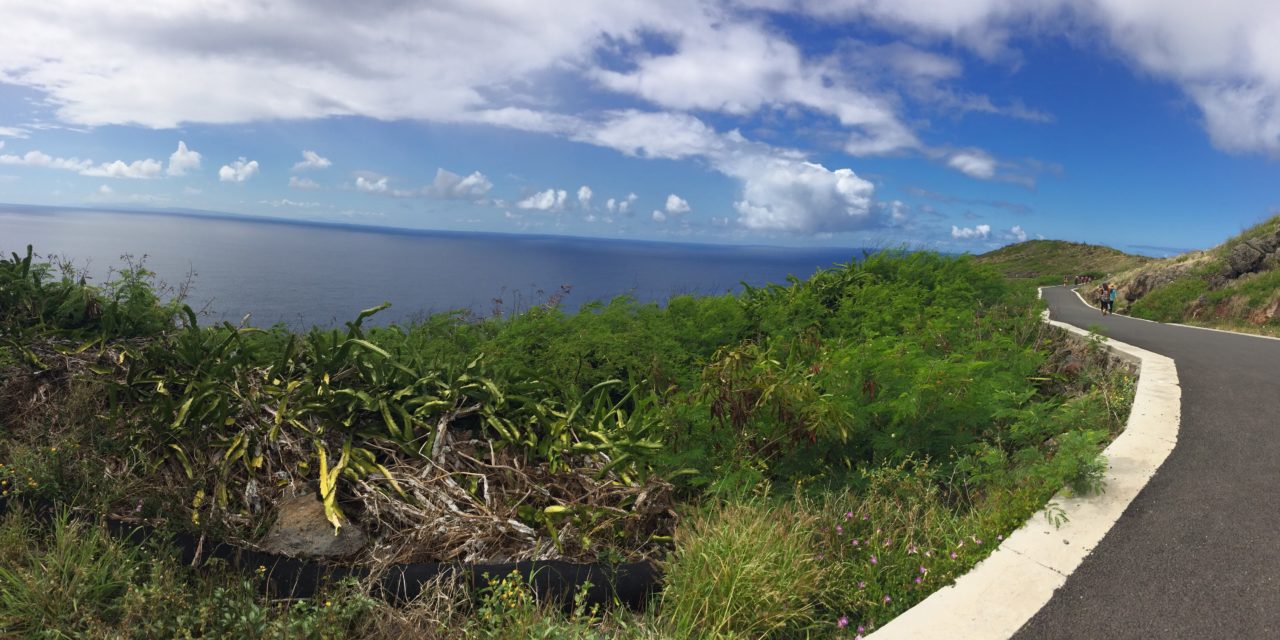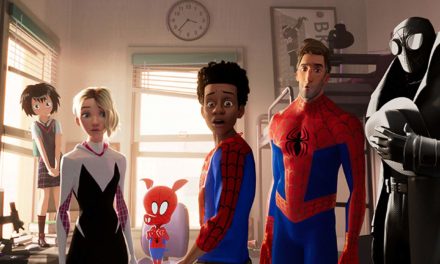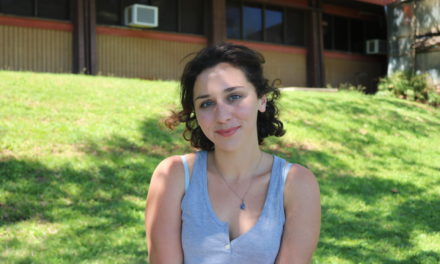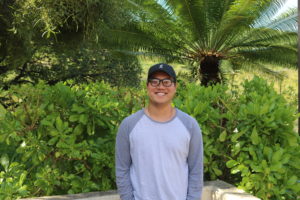By Gavin Arucan | Staff Writer
Out here in Hawaiʻi, in the middle of the Pacific, there’s not much to do besides explore the beautiful island we live on. Whenever you ask someone what their favorite pastimes are, the most common answer you’ll get is “go beach or hike.” While everybody has that list of several beaches they’ll keep returning to, most people love to find hiking spots that they’ve never trekked before.
Compiled below is a short list of some of my favorite and most iconic hikes on Oʻahu that every adventurous soul on the island should take on at least one.
Diamond Head
Difficulty: Easy
Length: 1.6 miles round trip; 1 hour
Pretty much everyone on the island has completed the Diamond Head hike, so there’s no surprise that it’s on this list. Located literally across the street from KCC, Diamond Head is the most popular and one of the easiest hikes on Oʻahu. It’s a steady uphill climb with a few stairs and tunnels along the way to the top, where you get a stunning view of the ocean and Waikīkī. It’s relatively short, making this the ideal hike for KCC students. It’s about a 5-minute walk up to the entrance from KCC, where you will have to pay a $1 admission fee ($5 if you drove and plan to park). If you start at noon, you’ll be done with the hike by 1:30 at the latest, just in time for your next class.
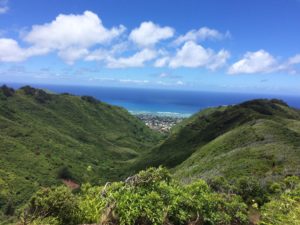
The view from the lower part of Hawai’i Loa Ridge. (Photo by Gavin Arucan)
Hawai‘i Loa Ridge
Difficulty: Medium
Length: 3.9 miles; 3-4 hours
Hawaiʻi Loa Ridge is the most secure hike I’ve come across. Located at the end of an upscale, gated community near Hawaiʻi Kai, you are required to sign in with security before entering. There are only 10 parking spots available near the trailhead, so it’s best to go early. Throughout the actual hike, you’ll encounter dozens of different types of trees, flowers, and other plants that make for a wonderfully diverse landscape. The trail is a fairly well-maintained dirt trail with both uphill and downhill climbs. There are stairs or ropes at several steep slopes to help you along.
Ka‘ena Point
Difficulty: Easy
Length: 5.9 miles round trip; 1-2 hours
At the westernmost point of Oʻahu, Kaʻena Point is more of a long walk than a hike. There’s very little change in elevation. However, it is the best place to be to enjoy the wildlife of the island. Kaʻena Point is a nature reserve various seabirds. It’s the only hike I know where you can observe albatross, monk seals, and sometimes whales at the same time in their natural habitat. There are two ways to enter Kaʻena Point. I’ve been to the entrance on the North Shore, at the end of Farrington Highway, just past Dillingham Air Field and Mokulēia Beach, but most people consider the Waiʻanae entrance the authentic way. Start at whichever point you choose, but make sure to take all your valuables out of the car with you, and please be respectful to all the plants and animals that live there. A couple of Punahou graduates killed more than a dozen albatross and destroyed 15 nests back in 2015. They have been charged on 14 accounts of animal cruelty and their trials have been making the rounds on local news for the last several months.
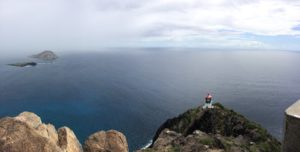
The lookout at Makapu’u trail provides a view of a lighthouse and Rabbit Island. (Photo by Gavin Arucan)
Makapuʻu Point
Difficulty: Easy
Length: 2 miles round trip; less than 1 hour
The newly renovated Makapuʻu Lighthouse trail is probably the safest hike on the island. It has a wide, paved path up to the lookout where you can see the famous lighthouse as well as Rabbit Island. This hike is ideal for a casual outing with friends due to how short and easy it is. For the slightly more adventurous, there are points to scale down the mountain to the beautiful tidepools below. As long as you keep an eye out for incoming waves, the tidepools are a great place to relax in calm, pristine waters.
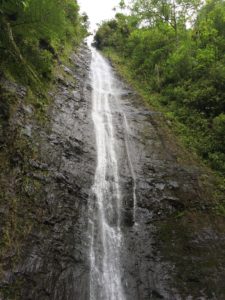
The waterfall. (Photo by Gavin Arucan)
Mānoa Falls
Difficulty: Medium
Length: 1.5 miles; less than 1 hour
Mānoa Falls is one of the easiest jungle hikes on the island, but, being a jungle hike, it’s still fairly difficulty. Because rainfall is common in the area, the trail is usually very muddy, so shoes are a necessity. There’s a $5 fee for parking, but I’ve never parked there since I have a friend who lives less than a mile away from the trailhead. There’s also a restaurant there called Treetops, but I’ve never bothered to check it out. At the end of the trail is the famous waterfall that the trail is named after. You can also climb up to the higher waterfalls that form a natural infinity pool, but it’s not very safe since there are only loose ropes and tree roots to assist you in the vertical climb. A Kaiser high school valedictorian died after falling from the upper waterfalls last year, so be careful if you decide to make the climb. The trail, like all jungle hikes, gets dangerously slippery while it’s raining, so do not attempt this, or any other jungle hikes during rainfall.

Many thrill seekers jump from the cliffs above the waterfall into the pond below at the Maunawili Falls trail. (Photo by Gavin Arucan)
Maunawili Falls
Difficulty: Hard
Length: 3 miles round trip; 3-4 hours depending on how long you stay
There’s been a lot of controversy over where to enter the Maunawili Falls trail recently. When I went, I parked in a residential area on Aloha Oe Drive, but, of course, the residents don’t like it when hikers park in front of their houses every day. There’s supposed to be an entrance at the nearby Royal Hawaiian Country Club, but it hasn’t been open for a long time. The city is forcing the golf course to reopen the trailhead, so it might be better to wait until the new trailhead is open by October 1 this year. The trail itself is a mere 3 mile round-trip hike, but it sure feels a lot longer. It’s always muddy, so be careful where you step. The mud can be knee deep if you step in the wrong spot, so wear hiking shoes. There trail is also littered with tree roots to traverse around and you have to cross a stream at least four times during the hike. When you’re closer to the waterfall, there are what seems like a million steps to climb up and down. You can find directions to the waterfall online, but I found it a lot easier to ask fellow hikers where to go. You need to walk upstream to finally reach the waterfall at the end of the trail, but it’s worth it. It’s a perfect place to swim and jump from short cliffs. I also noticed several crawfish in the stream, so it might be a good place to go crawfishing, although there are better spots for crawfishing that don’t require a few hours of hiking to reach. Do not enter the water with any open cuts, because, like every river and stream in Oʻahu, you’re at risk of leptospirosis if you do.
Mount Kaʻala
Difficulty: Hard
Length: 6.7 miles
I’ve never actually hiked Mount Kaʻala yet. It’s located in Waiʻanae Valley and is the tallest mountain on Oʻahu at a little over 4,000 feet tall. I can see the mountain range from my house, and I’ve always wanted to hike those mountains, I just never knew where to go until recently. I’m hoping to tackle this hike during the summer. From my research, Mount Kaʻala is daunting, with a few steep, rocky climbs with ropes and cables to assist you. The mountain range is almost alway foggy whenever I look towards it, so I imagine the top of the hike is usually foggy as well. There’s supposed to be a variety of plants and fungi along the way, so it’s a wonderful place to just enjoy nature. Whenever I pass by Waiʻanae Valley on my way to North Shore, it’s always a sight to behold, so I can’t wait to finally hike this one.
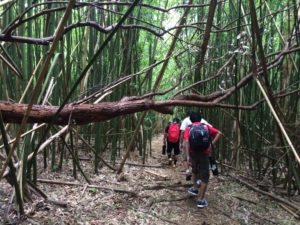
The bamboo forest. (Photo by Gavin Arucan)
Pauoa Flats
Difficulty: Medium
Length: 5 miles; 3-4 hours
There are several ways to enter the Pauoa Flats trail, but the best way is actually through Mānoa Falls. Just follow the narrow, uphill path to the left of the waterfall and you’re on your way. If you complete this hike, you’ll have killed two birds with one stone by also completing the Mānoa Falls trail. The hike will take you through a tropical jungle and a bamboo forest until you reach a lookout with a marvelous, vast view of Nuʻuanu Valley. The trail starts off very narrow and rocky, but it gets easier to traverse once you reach the bamboo area. It’s very windy when you near the top, and the sound of the rattling bamboo stalks is pleasing to the ear. There’s a bench at the lookout, so it’s a nice place to relax, enjoy the view, and eat the musubi you bought from 7-Eleven.
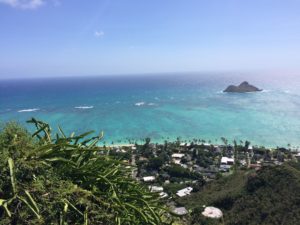
The view of Kailua and its popular beach. (Photo by Gavin Arucan)
Pillbox
Difficulty: Easy
Length: 1.6 miles; less than 1 hour
The Lanikai Pillbox hike is a very short but beautiful hike that’s popular for its scenic view of Kailua. It’s a rocky, uphill climb to the pillboxes, which were used in World War II, but it’s pretty easy and safe. It’s around a half hour hike up to the first pillbox and an additional ten or so minutes to the second pillbox, so most hikers hang out on top of the pillboxes for a while before heading back down to spend the rest of the day at Kailua beach. The trail does continue past the second pillbox, but most people turn around at that point.

